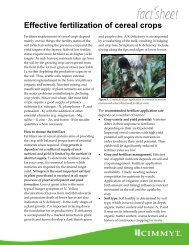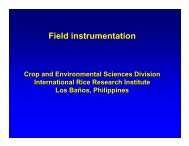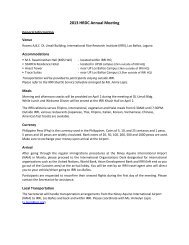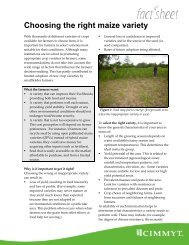Water management in irrigated rice - Rice Knowledge Bank ...
Water management in irrigated rice - Rice Knowledge Bank ...
Water management in irrigated rice - Rice Knowledge Bank ...
- No tags were found...
You also want an ePaper? Increase the reach of your titles
YUMPU automatically turns print PDFs into web optimized ePapers that Google loves.
<strong>Rice</strong> and water11.1 <strong>Rice</strong> environmentsWorldwide, there are about 150 million hectares of<strong>rice</strong> land, which provide around 550–600 milliontons of rough <strong>rice</strong> annually (Maclean et al 2002).<strong>Rice</strong> is unique among the major food crops <strong>in</strong> itsability to grow <strong>in</strong> a wide range of hydrologicalsituations, soil types, and climates. <strong>Rice</strong> is the onlycereal that can grow <strong>in</strong> wetland conditions.Depend<strong>in</strong>g on the hydrology of where <strong>rice</strong> isgrown, the <strong>rice</strong> environment can be classified <strong>in</strong>to<strong>irrigated</strong> lowland <strong>rice</strong> (79 million ha), ra<strong>in</strong>fed lowland<strong>rice</strong> (54 million ha), flood-prone <strong>rice</strong> (11 millionha), and upland <strong>rice</strong> (14 million ha). Lowland<strong>rice</strong> is also called “paddy <strong>rice</strong>.” Lowland <strong>rice</strong> fieldshave saturated (anaerobic) soil conditions with pondedwater for at least 20% of the crop’s duration.In <strong>irrigated</strong> lowlands, the availability of irrigationassures that ponded water is ma<strong>in</strong>ta<strong>in</strong>ed for at least80% of the crop’s duration. In ra<strong>in</strong>fed lowlands,ra<strong>in</strong>fall is the only source of water to the field andno certa<strong>in</strong> duration of ponded water can be assured(depend<strong>in</strong>g on vagaries of ra<strong>in</strong>fall). In flood-proneenvironments, the fields suffer periodically fromexcess water and uncontrolled, deep flood<strong>in</strong>g (morethan 25 cm for 10 days or more). Deepwater <strong>rice</strong>and float<strong>in</strong>g <strong>rice</strong> are found <strong>in</strong> these environments.Upland <strong>rice</strong> fields have well-dra<strong>in</strong>ed, nonsaturated(aerobic) soil conditions without ponded water formore than 80% of the crop’s duration.1.2 Irrigated lowlandsThe 79 million ha of <strong>irrigated</strong> lowlands provide 75%of the world’s <strong>rice</strong> production (Maclean et al 2002;Fig. 1.1). At the turn of the Millennium, countryaverage<strong>irrigated</strong> <strong>rice</strong> yields <strong>in</strong> Asia ranged from 3to 9 t ha –1 , with an overall average of about 5 t ha –1(Maclean et al 2002). Irrigated <strong>rice</strong> is mostly grownwith supplementary irrigation <strong>in</strong> the wet season, andis entirely reliant on irrigation <strong>in</strong> the dry season.Significant areas of <strong>rice</strong> are grown <strong>in</strong> rotation witha range of other crops, such as the 15–20 million haof <strong>rice</strong>-wheat systems (Tims<strong>in</strong>a and Connor 2001,Dawe et al 2004). Irrigation systems vary widely,and <strong>in</strong>clude Individual pump irrigation from shallowtubewells (down to about 15-m depth). Small- to medium-scale community-basedpump irrigation from deep wells (down to200–300-m depth). Small- to medium-scale community-basedsurface irrigation where water is divertedfrom ponds or reservoirs (for example,the tank system <strong>in</strong> southern India and SriLanka). Small- to medium-scale community-basedsurface irrigation where water is directlydiverted from a river (run-off-the-river irrigation). Large-scale surface irrigation where water isdiverted from reservoirs or lakes. Conjunctive groundwater-surface-waterirrigation schemes (can be small to largescale).In each type of system, the ownership andcontrol of water may vary widely.1.3 The <strong>rice</strong> field and its water balanceIrrigated lowland <strong>rice</strong> is grown under floodedconditions. Mostly, <strong>rice</strong> is first raised <strong>in</strong> a separateseedbed and subsequently transplanted <strong>in</strong>to the<strong>rice</strong> field when the seedl<strong>in</strong>gs are 2–3 weeks old.





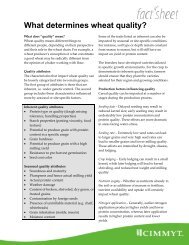

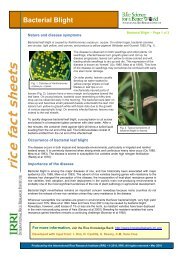

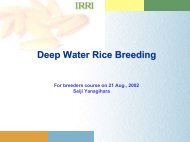
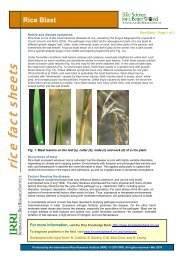
![International Standards' Organization â Rice Specification [ISO 7301]](https://img.yumpu.com/36696862/1/190x245/international-standards-organization-a-rice-specification-iso-7301.jpg?quality=85)

